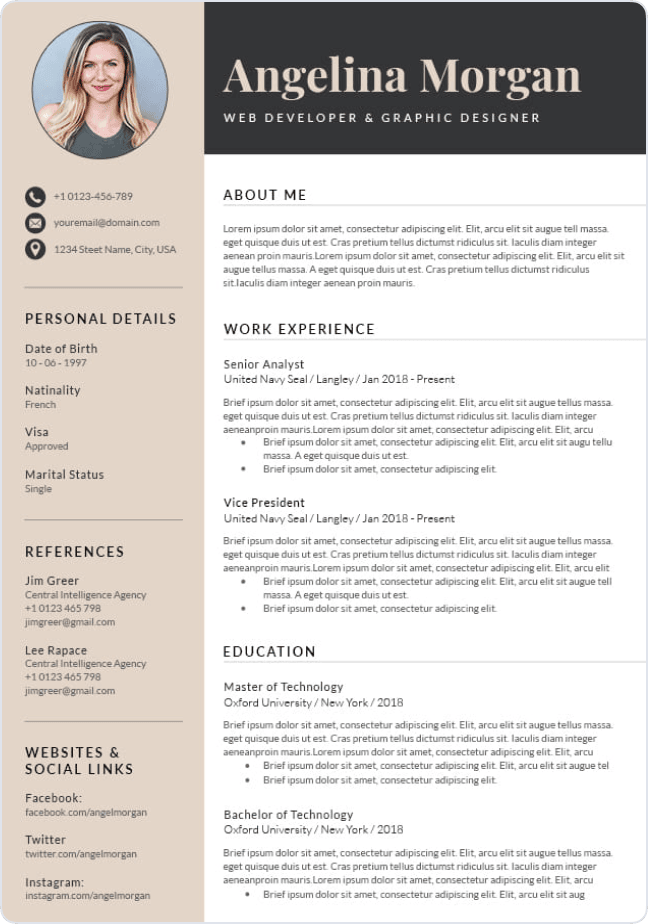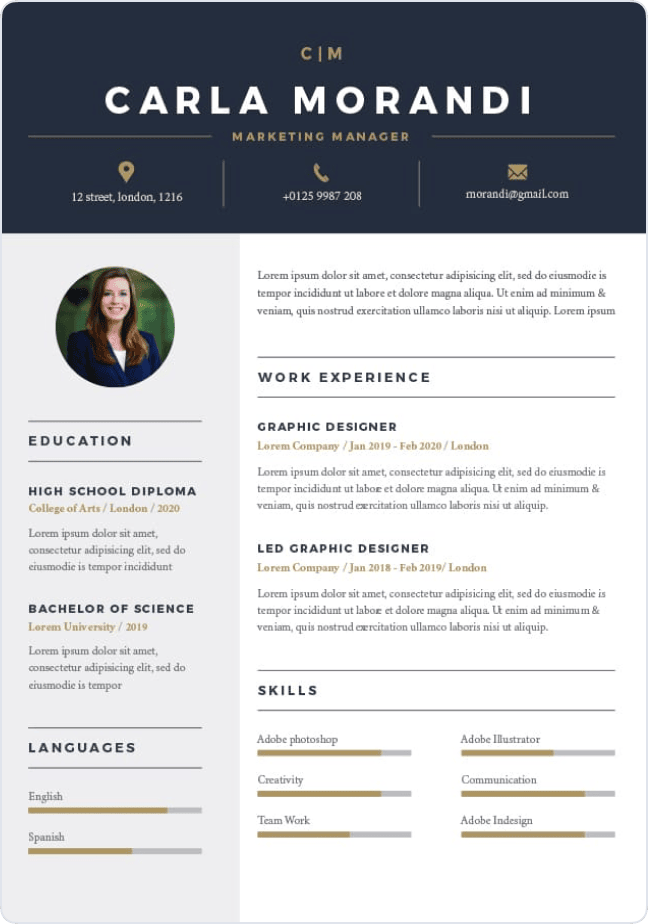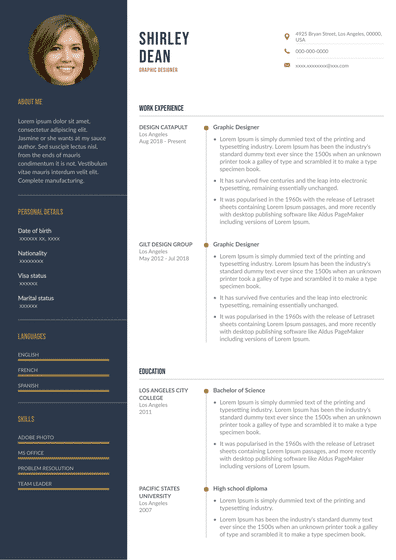Having a biomedical engineer resume that highlights your top achievements plays a significant role in ensuring that you get your dream job. It gives the hiring manager information on who you are and why you're the best person for the job. You can check out our resume examples which have some great tips that will allow you to write an exceptional resume.
Here is some of the information you'll get in this article:
- A biomedical engineer resume sample that you can use as a guide.
- Excellent tips to help you write an attractive work experience section.
- A guide on how to structure your biomedical engineering resume.
- The skills you need in your resume for biomedical engineering.
Job prospects for Biomedical Engineers
According to the U.S. Bureau of Statistics, the employment of bioengineers and biomedical engineers is projected to grow 6 percent from 2020 to 2030.
The industries with the highest levels of employment in Bioengineers and Biomedical Engineers include:
- Medical equipment and supplies manufacturing
- Scientific research and development services
- Pharmaceutical and medicine manufacturing
- Navigational, measuring, electromedical, and control instruments manufacturing.
- General medical and surgical hospitals
The average yearly salary for a biomedical engineer depends on the years of experience, education, and skills as follows:
- 0-2 years $59,000
- 2-4 years $68,000
- 4-7 years $79,000
- 7+ years $100,000

What You Need To Know To Write A Professional Resume For A Biomedical Engineer
Hiring managers take a few seconds on every resume, so this means that you have to get their attention quickly.
Start with your most relevant accomplishments that will immediately entice them to read your resume more.
List your most relevant skills and professional experiences to show the recruiter you're a strong candidate and have what it takes to do the job.
Use the correct resume format and layout for your resume.
Let's look at some of the formats you should consider.
The reverse-chronological order focuses on your professional experiences and is perfect for candidates who've worked in the biomedical engineering field for some time.
The functional resume, also known as a skills-based resume, focuses on your skills or unique abilities that allow you to perform your duties effectively. If you've recently graduated or are changing careers, this format is perfect for you.
The combination/hybrid resume format blends some of the features of the reverse-chronological and functional resume formats. Individuals with years of experience and the required skills can use this format.
The layout of your resume
Your resume layout should be simple to read and understand.
If you prefer to use a biomedical engineer resume template or resume builder, ensure that it's not too complicated and all the vital information is easy to find.
Use a font size of 10-12pt and easy-to-read fonts like Times New Roman, Calibri, Cambria, Helvetica, and Arial.
The structure of your biomedical engineer resume should have the following sections:
- The header section
- Resume summary/resume objective
- Work experience section
- Education section
- Skills section
- An additional section (volunteer work, computer skills and certifications, languages, awards/honors, and interests)
Check out our other resumes that you might be interested in:
- Medical assistant resume
- Sample Resumes For Medical
- Environmental engineer resume
- Biologist engineer resume
Start Your Resume For Biomedical Engineer With A Header
This section of your resume is simple to write but highly crucial. Here are some of the details you'll add to this section:
- Your full name
- Job title
- Phone number
- Professional email address
- Location
- A link to your LinkedIn profile.
Your contact details must be correct; otherwise, you'll miss out on the job if the recruiter can't reach you.
Biomedical Engineer
899-124-975
tiffanywells@gmail.comLoxley, AL
linkedin.com/in/tiffanywells
 INCORRECT
INCORRECTBiomedical Engineer
899-124-975
tiffanywells@gmail.com2054 Joyce Street
House number 21
Loxley, AL
Date of birth 04/07/1999
linkedin.com/in/tiffanywells
.png)
Do You Need A Photo On Your Resume?
In most instances, adding a photo on your resume works against you, so it's better to leave it out. However, if the recruiter asks you to send one, you should, but ensure it's a professional photo.
How To Add Your Work Experience As A Biomedical Engineer
Most recruiters love to spend a little more time on this section, so don't also be in a hurry when adding your professional experiences.
Describing your employment history allows the recruiter to see what you've previously done and how your expertise can be helpful in the new biomedical engineer position.
Hiring managers use software known as ATS systems to filter out resumes that don't fit the criteria. One way of beating this software is using the same language used in the job description when adding your roles and responsibilities.
If you want to stand out, use facts and figures to quantify your achievements, as this gives a clear picture of the value you'll bring to the company.
While it might be tempting to add all your work experiences, including those not directly related to the job, it's always better to focus on the relevant professional experiences.
This section should have the name of your workplace, the job title, and the years you've worked at each place. Check out our resume templates which will help you structure this section.
Biomedical Engineer
April 2017-July 2019
- Worked with ten manufacturers to purchase and sell medical devices and was in charge of medical equipment management.
- Trained over 50 clinicians and biomedical engineer interns on how to use a biomedical device safely and offer biomedical support.
- Installed and calibrated biomedical machines, equipment, and software programs at four medical facilities and conducted clinical research studies.
- Created and designed biomedical technology used for diagnosing and treating medical problems, including artificial internal organs.
 INCORRECT
INCORRECTBiomedical Engineer
November 2014-June 2016
- Installed and maintained biomedical equipment.
- Published technical reports.
- Researched biological systems of humans and animals.
What Do You Need In Your Education Section For Your Biomedical Engineer Resume
A biomedical engineer should be well-educated to stand out for a job in this field.
That means that this section of your resume should be exceptional. If you have an educational qualification that will set you apart, don't leave it out of your resume.
Usually, the minimum requirement for most biomedical engineer jobs is a bachelor's degree but having a Master's degree increases your chances of landing the job. It's okay if you don't add your high school diploma if you have your Master's degree in biomedical engineering or a related field.
Here are the details you'll include in this section:
- The name of the degree
- The name of the school
- Year of completion/graduation
Correct example
Massachusetts Institute of Technology
June 2015
Bachelor's degree in Biomedical Engineering
Massachusetts Institute of Technology
December 2013

What Are The Essential Skills That Every Biomedical Engineer Should Have In The Resume?
The skills section of your resume consists of the soft and technical skills that allow you to do your job diligently. You can use biomedical engineer resume samples to assist you in writing this section.
While you may think that all you have to do is list a bunch of skills, there are a few things you should consider to allow you to stand out.
First, language matters, and the job description will help you. Before you start adding your skills, check the job description, which usually contains some of the skills that you need in your resume.
You'll notice that the wording may differ from yours even though it's the same skill. Use the words that the recruiter has used. For example, Excellent communicator instead of communication skills.
Another thing is that you should use bullet points to list your skills because this makes it easy for the recruiter to see everything even as they take a glance at your resume.
Let's look at some of the skills you should consider for your biomedical engineer resume.
Hard skills- Statistical analysis
- Quality control
- Biomedical instrumentation
- Safe Medical Device Act(SMDA)
- Biosignal processing
- Computational modeling
- Research and Data Analysis
- Patient monitoring systems and devices
- Written communication skills
- Excellent customer service
- Teamwork
- Leadership skills
- Interpersonal skills
- Multitasking skills
- Problem-solving
- Organization skills

Write An Outstanding Professional Summary
The summary statement comes right after the header section at the top of your resume. This section summarizes your resume by highlighting your experience, top skills, and achievements. It's usually short with two to four sentences, but it has to be extremely good to get the recruiter's attention and interest them in reading the rest of your resume.
The field of biomedical engineering is broad, so if you have specialized in a specific area, you should mention it as this can increase your chances of landing an interview.
 INCORRECT
INCORRECTWhen To Use A Professional Objective
A professional objective does the same job as a professional summary. It's suitable for recent graduates and career changers to summarize their career goals and show the recruiter how they align with the company goals. A resume objective also allows you to express your interest in the job and should be short but catchy and engaging.
Why You Need An Additional Section In Your Biomedical Engineer Resume
Your resume is incomplete until you include an additional section. This section sets you apart from everyone else because it contains your extra qualifications.
This is where you add the skills and achievements you want to highlight and don't want the recruiter to miss. The idea is to ensure that you stand out as a unique candidate when your potential employer looks at your resume.
Here are some of the sections you can consider for your resume.
Computing Skills & Certifications
A biomedical engineer requires specific computing skills to develop medical devices, test them and analyze data. These skills are easier to spot on the resume if they have their section. Some computing programs that allow a biomedical engineer resume to stand out include CAD software, MATLAB, and LabView.
Certifications always get the recruiter's attention because they show that you have additional training. Here are some certifications that will elevate your resume for biomedical engineering.
- Certification in Clinical Engineering
- Certified Biomedical Auditor
- Certified Reliability Engineer
Languages
Language skills always allow you to stand out, so you should add them to their section to ensure your potential employer doesn't miss them. Use the official language reference when listing the languages as follows:
- TOEFL for English
- Germany's Goethe-Zertifikat (70%) or higher is required.
- DELF for French (with a score of 60% and above)
- SIELE for Spanish
Interests
Your interests show that you're a diverse candidate, so don't shy away from adding them to your resume. However, it's always advisable to focus on interests that build on your skills, such as blogging/podcasting, baking, hiking, or painting. Watching TV and listening to music are not the best interests to add to your resume.
Top Tips To Boost Your Resume
- Always proofread your resume to ensure it's free of mistakes that could cost you the opportunity.
- Use the job description to get the exact wording you should incorporate in your resume.
- Tailor each resume to match the job you're applying for, and avoid using one generic resume.
- Ensure that your job title is keyword optimized.
- Keep your resume short and let it be one page long.
- Consider using a resume template to structure your resume and add all the required sections.
- Add keywords and action verbs to help your resume get past the ATS systems.
Summary: Main Takeaways for Writing a Professional Biomedical Engineer Resume
- Your contact details in the header section must be accurate.
- Write a strong resume summary/objective to get the recruiter to read the rest of your resume.
- Use the work experience section to add your employment history and quantify your results with figures and facts.
- Your education section should have all your educational qualifications, but if you have a Master's, you can leave out the high school diploma.
- Use bullet points to list your skills and make them easy to spot in your resume.
- An additional section can help set you apart from your competitors.
A Biological Engineer Cover Letter Is Vital
A resume without a cover letter makes the application incomplete. If you have impressive writing skills and love to inject some personality into your writing, this document allows you to do that. You get to expound on your qualifications and express your interest in the position. In some rare cases, the recruiter will ask you not to send a cover letter, and in such a case, you shouldn't send one. Here are our cover letter examples which are a great guide if you want to create your own.
Frequently Asked Questions
Which companies are hiring biomedical engineers?
According to Glassdoor, the companies hiring biomedical engineers include:
- Medtronic
- Stryker
- Philips
- Texas A&M University
- Johnson and Johnson
- Kaiser Permanente
- BYJU'S
- Epic
- The John Hopkins University
- Roche
Which careers can you get into with a Biomedical engineering degree?
- Biomaterials developer
- Biomedical researcher
- Clinical engineer
- Manufacturing engineer
- Orthopedic bioengineer
Choose from Our 5 Best Templates for Your Resume


























